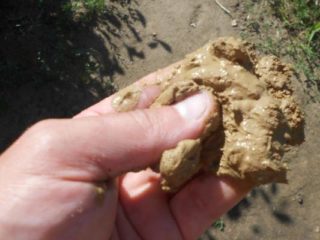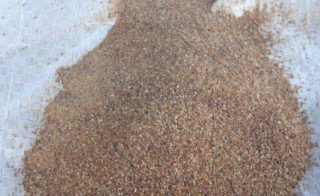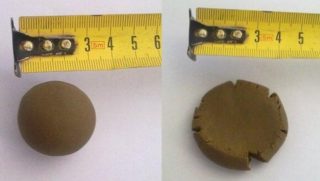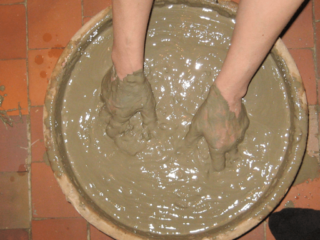The burning temperature of firewood is 500-1050 C. Not every stone and solution can withstand such a load. The furnace is constructed of refractory fireclay and clay bricks, and instead of the usual cement, a clay composition is used. The proportions of clay and sand in the solution for the furnace must be strictly observed, otherwise the masonry will be fragile, and the furnace will be short-lived.
Work tools
To make a masonry mixture, you need a minimum of tools and materials:
- clay - red, rather oily, plastic;
- sand - river quartz and fireclay;
- water is ordinary but pure;
- shovel and trowel;
- buckets, troughs, barrels for preparing clay and kneading the solution;
- any device for mixing.
In the store you can buy ready-made dry mortar for the construction of furnaces. In this case, only water, a bucket and a mixer are needed for cooking.
Sand selection and preparation
To build different parts of the furnace you need different sand. The highest temperature during combustion is observed in the combustion chamber. A mixture of clay and fireclay sand is prepared for the furnace. It is made by crushing fireclay bricks. In fact, this is crushed clay after low-temperature firing.
For laying the body and chimney channels, a solution based on clay and river sand is taken. Its difference is high uniformity, medium and small particle diameters, and roundness of shape. River sand is very clean, does not contain mechanical impurities and practically does not include organic additives. It is used in the manufacture of plaster: in the store they are looking for material with the corresponding marking.
Since the sand extracted from the bank or bottom of the river includes different fractions, it must be sieved before work. For the solution, a medium and fine fraction is needed: large particles lead to strong shrinkage of the solution when dried. In addition, the material must be washed. To do this, you will have to make a device from a metal pipe with a conical end.
Clay fat level
Clay is a microgranular mineral of complex composition. Differs in elasticity, water resistance, good adhesion to a stone. For masonry mortar take red clay. The material is pre-cleaned.
The main characteristic of the mineral is fat content. This parameter determines the quality of the future stove. Excessively greasy, when hardening, actively evaporates moisture and cracks. Over time, such a solution crumbles. Too thin material is not flexible enough to hold bricks together.
Before kneading clay for the furnace, determine its fat content. There are several ways:
- A handful of dry material is soaked in water and knead in a fist. If the composition has taken the consistency of plasticine, the clay is oily. If crumbles into crumbs - skinny.
- The mineral is mixed with water - for 0.5 l 100-150 ml of water, knead and make balls in 45-50 mm. One of them is flattened into a cake. Crafts leave to dry for 2-3 days. If cracks have formed after 3 days, the clay is too oily. If you drop the ball from 1 m to the floor, and it does not break, the mineral is normal. If broken - too skinny.
- The most accurate way: make a ball from clay dough and squeeze it between two planks until cracks form on it. Mineral is judged by their size. If the ball crumbles even with slight compression, it’s skinny. If thin cracks appear when the ball is half compressed, the material is greasy.Clay is considered optimal, the balls from which give cracks when flattened by 1/3.
Both oily and skinny clay can be applied by selecting the right amount of sand.
How to set the quality of the solution
Only normal solutions are suitable for laying a stove in a house or in a bath. Greasy after hardening crumbles. And since the furnace is operated actively, it happens very quickly. Skinny solutions do not guarantee the strength of the walls, which is unsafe.
Since it is difficult to accurately measure the performance of materials without devices, they resort to another method. Mix 5 solutions with different concentrations of sand and clay and determine the suitability of each composition. The technology is as follows.
- Prepare 5 equal servings of clay. The first is left unchanged, in 2 samples add 10% sand, in 3 - 25%, in 4 - 75%, and in 5 clay and sand will be in equal volume.
- So much water is added to each serving to make a thick dough from each sample.
- Balls with a diameter of 4–5 cm and plates with a thickness of 2–3 cm are molded from portions. They are left for 10–12 days to dry. The sample should dry indoors at room temperature.
- If the balls and plates crack during drying, the composition is greasy, more sand needs to be added to it. If the plates are painted, and the balls break when dropped - the mixture is skinny, more clay should be put. If during a fall the clay craft does not crumble, the solution has the desired fat content and plasticity. In the manufacture of the mixture, sand and clay are mixed in the same proportions as in this sample.
At the stage of manufacturing large portions pay attention to the density of the composition. If there are gaps in the surface when the trowel is held on the surface, the mixture is too thick. If traces of the trowel quickly fill liquid - the mixture is liquid. She needs to settle, and drain the excess water.
In the right solution, the trowel leaves a mark without scouring, and the grooves swell very slowly.
Options and solution preparation technology
For the laying of furnaces, the proportions of clay and sand are selected based on the characteristics of the materials available. If the clay is oily, increase the proportion of sand, if lean - less than quartz. As a result, a good composition for the furnace is obtained experimentally.
How to mix the solution
A masonry composition is prepared according to several “recipes”. The technology of the most affordable method:
- Clay is soaked for 2-3 days in a wooden box or in a tin can. After 3 days, lay sand and, putting on boots, trample the mixture until all lumps are broken.
- Then the solution is kneaded with a tamper and hands to grind all the small lumps.
- A normal mortar suitable for building a furnace slides off a shovel, but does not drain. If you lay a layer of 3-4 mm between 2 bricks, after 5 minutes the stones will no longer come off from each other.
- If the mixture is too oily, add sand - not more than 15% of the volume, and repeat all the manipulations.
The following method is recommended if normal clay is used.
- First, they build a wooden floor with bumpers - strikers.
- Clay is laid in layers on the striker and moistened with water. When the material softens, it is turned over, raked into piles and beds, flattened and whipped with a shovel into slices. All these operations are repeated until the solution becomes completely homogeneous.
High uniformity is achieved faster when using the 3 method. It is effective, but also laborious. The clay for soaking is stacked in barrels, then the mixture is filtered through a sieve with cells of 3 * 3 mm. Sand added to the composition is also sifted. If the consistency is too thick, dilute with water.
The ratio of sand and clay
The volume and ratio of ingredients vary within a very wide range. The optimal combination is the proportion of sand to clay 1: 2 or 1: 1. The volume of water is approximately ¼ of the amount of mineral.
In fact, the proportion determines the fat content of the mineral. At high fat content, 2 fractions of clay may account for 4 fractions of sand. If the material is lean, the proportion of sand is halved.
Solution Quality Check
The quality of the solution is checked by a variety of methods. The most affordable is the draining of material from a shovel, performed right during cooking.
A reliable result is a tactile test. The normal composition creates a rough layer on the fingers. Bold forms a film, sticks on the palms. Skinny leaves no traces.
Visually assess the quality of the mixture using a regular wooden stick. After immersion in a normal solution, traces and particles of the mixture remain on it, in a greasy - dense film. A lean solution leaves no traces, the tree remains wet.
The most reliable practical method is laying a layer between bricks. If the solution is sufficiently thick and greasy, after 5 minutes the bricks do not come off from each other. If bold - this effect is observed even when a very thin layer is laid, not more than 2 mm. If skinny - the bottom brick will fall.








